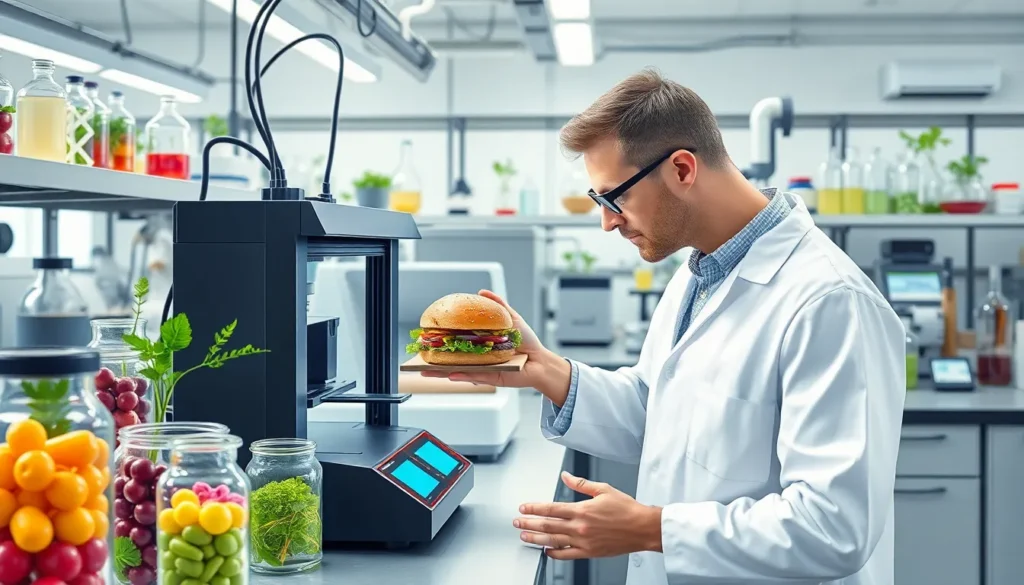In a world where food can be grown in labs and burgers can be 3D printed, innovative food science is shaking up the culinary landscape like never before. Gone are the days of simply cooking; now it’s all about engineering flavors, textures, and even nutrition. Imagine biting into a perfectly crafted meal that not only tantalizes your taste buds but also boosts your health—no magic wand required.
Emerging technologies are transforming how we think about food, from artificial intelligence predicting our cravings to sustainable farming practices that make Mother Nature proud. It’s a delicious revolution, and it’s happening right under our noses. So buckle up and get ready to explore how these advancements are redefining what’s on our plates and in our hearts—because who wouldn’t want to be part of the future of food?
Table of Contents
ToggleOverview of Innovative Food Science
Innovative food science plays a crucial role in transforming how people approach food production and consumption. Advancements in this field enhance flavor, nutrition, and sustainability.
Definition and Importance
Innovative food science encompasses the study and application of new technologies in food production. This discipline addresses current challenges like food security and sustainability. It integrates principles from various scientific fields, including biology, chemistry, and engineering. Using innovative techniques, researchers can create healthier food options and reduce waste. Moreover, its significance lies in the potential to revolutionize dining experiences while promoting environmental stewardship. Enhancing food quality aligns with global health trends and consumer demands, creating a more sustainable food system.
Key Areas of Research
Innovative food science includes several key research areas. The development of lab-grown meat offers a sustainable alternative to traditional livestock farming. Alternatives to plastic packaging aim to reduce environmental impact while maintaining food safety. Furthermore, advancements in fermentation technology promote the creation of functional foods that support gut health.
Artificial intelligence enhances food production efficiency and optimizes agricultural practices. Research into precision agriculture supports sustainable farming methods by utilizing data analytics for better crop management. These areas of investigation not only improve food quality but also encourage eco-friendly practices across the industry. Each focus area contributes to reshaping the future of food.
Emerging Technologies in Food Science

Emerging technologies drive significant advancements within food science. These innovations enhance food production methods and improve nutritional value, creating a sustainable food system.
Biotechnology in Food Production
Biotechnology transforms food production by introducing genetically modified organisms that resist pests and diseases. This method reduces reliance on chemical pesticides, fostering eco-friendly agriculture. Researchers develop bioengineered crops that exhibit increased yield and nutritional content, addressing global food security. Examples include biofortified staples, such as rice enriched with vitamins. Techniques like CRISPR allow for precise genetic edits, leading to enhanced traits in crops for improved performance.
AI and Machine Learning Applications
Artificial intelligence and machine learning create remarkable opportunities in food science. These technologies optimize supply chain management by predicting demand and minimizing waste. Algorithms analyze data from various sources, enabling the identification of consumer preferences and trends. Additionally, AI aids in product development by simulating flavors and textures before physical production. For instance, machine learning tools help scientists design new food products that align with health trends, ensuring they meet consumer expectations.
Sustainable Practices in Food Technology
Sustainable practices in food technology focus on minimizing environmental impact and enhancing food security. Strategies target waste reduction and the use of alternative ingredients.
Reducing Food Waste
Reducing food waste remains a critical priority within food technology. Studies reveal that around 1.3 billion tons of food waste occurs annually, highlighting the urgency for effective solutions. Technologies such as smart packaging and preservation techniques extend shelf life and enhance food safety. Innovations like precise monitoring systems track inventory and consumption patterns, helping businesses adjust production and reduce overstock. Efficient supply chain models also optimize distribution, ensuring food reaches consumers quickly, minimizing spoilage. Various apps connect consumers with surplus food from retailers, promoting redistribution and encouraging responsible consumption. Collectively, these strategies contribute to environmental sustainability and mitigate unnecessary food disposal.
Alternative Proteins and Ingredients
Alternative proteins and ingredients emerge as pivotal elements in sustainable food systems. Meat alternatives like lab-grown products, plant-based options, and insect protein offer diverse protein sources while reducing resource consumption. Research indicates that lab-grown meat can decrease greenhouse gas emissions by up to 90% compared to traditional livestock farming. Plant-based proteins, including lentils and chickpeas, require less land and water, indicating their environmental advantages. Innovations in fermentation technology also create nutritious ingredients with minimal environmental impact. These alternatives not only cater to consumer demand for sustainable choices but also enhance global food security by providing varied dietary options. Emphasizing alternative ingredients paves the way for a more resilient and sustainable food future.
The Future of Food Innovation
Food innovation is rapidly evolving, driven by cutting-edge technologies and a focus on sustainability. Emerging trends are shaping how individuals produce, consume, and perceive food.
Trends to Watch
The rise of plant-based diets leads the charge in culinary advancements. Lab-grown meat continues gaining traction, appealing to environmentally conscious consumers. Innovations in fermentation are creating novel flavors and nutritional benefits, increasing interest in probiotics. Precision agriculture techniques enhance crop yield while minimizing resource usage. Robotics and automation in food production streamline processes, enhancing efficiency in farms and kitchens. Innovations in food delivery systems, such as drone technology, offer convenience in urban areas.
Impact on Global Food Security
Innovative food science plays a crucial role in addressing food security challenges. Progress in bioengineered crops allows for the cultivation of resilient species, capable of thriving in changing climates. Enhanced nutritional content in these crops can combat malnutrition effectively. Emerging smart agricultural practices optimize land use, reducing dependency on harsh chemicals and promoting sustainability. Improvements in food preservation methods reduce waste significantly. Technologies that detect spoilage help ensure food safety during distribution, directly impacting the availability of fresh produce. These developments create a promising future for global food systems, advancing access to nutritious options for all.
The future of food is being reshaped by innovative food science and emerging technologies. These advancements not only address pressing issues like food security and sustainability but also enhance the culinary experience. As lab-grown meats and alternative proteins gain traction consumers are presented with healthier and more sustainable options.
Technologies like artificial intelligence and precision agriculture are streamlining production and minimizing waste. This evolution in food science promises to create a more resilient food system that meets the demands of a growing population. Embracing these innovations will pave the way for a healthier planet and a more nutritious future for everyone.






